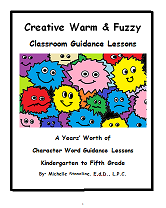Bringing Psychology to Counseling, by Martha Nodar, Mercer Counseling Student
by Martha,
(Atlanta, GA)
Bringing Psychology to Counseling
My idea of bringing a touch of psychology to counseling involves having a genuine interest in authenticity and a fairly good understanding of what drives human behavior.
The journey of self-discovery is an on-going process for both counselors and their clients and I cannot imagine making this journey without bringing psychology along as a fellow traveler.
For instance, in my journey I bring along the work of those I respect such as Freud’s, Jung’s, and Bowen’s as my faithful companions. This does not necessarily mean that I may agree with 100% of their ideas. But, it does mean that I recognize their vast contributions to advancing academic inquiry.
Developed by Freud in the late 19th century, the psychoanalytic theory proposes that most of human behavior is primarily driven by unconscious motivations. The unconscious, according to psychoanalysts such as Freud, Jung, and Bowen, is the part of the mind that remains out of our conscious awareness for the most part.
As destiny would have it, it was Bowen, a pioneer in family therapy, who expanded Freud’s theory of psychoanalysis during the second half of the 20th century and tied it to family counseling; thus, forming the basis for the Bowen’s Theory (Kerr & Bowen, 1988).
Bowen has helped us understand how the relationship we have with ourselves (intrapersonal dynamics) is reflected in the relationship we have with others (interpersonal dynamics).
For me, bringing psychology to counseling means we want to go deeper rather than just looking at the presenting symptoms at the surface. Bowen champions self-awareness in counselors and argues that whether or not a counselor may be able to go deeper with a client would depend on the counselor’s level of self-awareness (Kerr & Bowen, 1988).
Working toward self-awareness is not always easy. Fortunately, we have wonderful ways to sail through it—in the sand. Sandtray and Sandplay were both created to facilitate the process of self-awareness.
Sandtray and Sandplay are both psychotherapeutic, nonverbal, nondirective methods that involve using symbols and metaphors while providing a safe environment for the sandplayer (Homeyer & Sweeney, 2011).
Influenced by child psychoanalysts of her time such as Anna Freud and Melanie Klein, British pediatrician and child psychologist Margaret Lowenfeld was the pioneer behind Sandtray Therapy, which was originally designed for children in the 1920s.
Decades later and inspired by Lowenfeld, Swiss Jungian analyst Dora Kalff conceived Sandplay Therapy and based it on Jung’s theories, thus, viewing the sandplayer’s journey through Jung’s lens.
Motivated by Kalff’s concept of applying Sandplay to adults, Lowenfeld then extended Sandtray to adults in addition to children.
Although the terms Sandtray and Sandplay are frequently used interchangeably, it bears to recap their differences:
Sandplay was designed by Kalff and it is practiced only with adults, remaining solely faithful to Jung’s theories.
Sandtray was designed by Lowenfeld and it is generally practiced with both school-age children and adults. Sandtray may be used applying the Jung’s approach, the humanistic approach, CBT, or an eclectic integration.
Sandplay and Sandtray also have many commonalities: In both Sandplay and Sandtray, the important thing to remember is that the action takes place in a wooden box full of sand that is believed to contain the material found both in the conscious and the unconscious parts of the psyche. Sandtray and Sandplay are both visual representations of a sandplayer’s wishes, fears, and motivations. It could be argued that the sand box full of miniatures is a snapshot of the sandplayer’s psyche (Homeyer & Sweeney, 2011).
Moreover, the collective unconscious is bound to show up in some of these trays. According to Jung, the collective unconscious is found within our individual unconscious, but contains common ancestral archetypes—universal representations of typical patterns of human behavior (Jung, 1961).
According to Jung, all archetypes exist on a continuum and have both a neutral side and a shadow side--which is Jung’s idea of the unconscious. The shadow side is supposed to have our human imperfections. Jung believes that in order for us to be whole as individuals, we must become aware of our shadow side. It bears to mention that Jung’s theories focus on adults.
Archetypes may come to the surface when we least expect it and even surprise us. For example, the Saboteur is a common archetype related to self-esteem (Myss, 2001). The neutral side of the Saboteur tends to be wise, and is responsible for keeping us safe by preventing us from making grave mistakes. On the other hand, the shadow side of the Saboteur is adamant about preventing change almost at any cost, thus, carrying the potential of jeopardizing our opportunities for growth.
All adults have the Saboteur archetype at some level and to some degree (Myss, 2001). I would suggest that the Saboteur archetype may be more of a frequent visitor in the counseling room than many may be willing to admit.
In my view, bringing psychology to the counseling session means becoming aware of our shadow side and bringing the self out of hiding. . .for both the client and the counselor.
The journey of self-discovery begins with us, the counselors. We cannot take our clients where we have never been. I would argue that bringing psychology to counseling smoothes the sailing in this journey we call life.
Let’s meet in the sand. . . :).
References
Homeyer, L., & Sweeney, D. (2011). Sandtray therapy: A practical manual (2nd ed.). New York, NY: Routledge.
Jung, C. (1961). Memories, Dreams, Reflections. Jaffe, A. (ed.). New York, NY: Vintage Books.
Kerr, M., & Bowen, M. (1988). Family Evaluation. New York, NY: W.W. Norton & Co.
Myss, C. (2001). Sacred contracts. New York, NY: Harmony Book
Disclaimer: This website and its content is intended for trained licensed mental health professionals and school certified mental health professionals to use for their clients / students at their own discretion.
*If you ignore the disclaimer above are using these techniques on yourself and you feel any discomfort or upset it is highly suggested that you seek out a licensed mental health professional immediately.
"Beyond Art Therapy" is the concept from Dr. Stangline that combines all creative fields in therapy. It is not the traditional "art therapy" but goes beyond to include sand tray therapy, play therapy, mindfulness, meditation, color therapy, cognitive behavioral therapy, and a vast majority of other therapies.
For any other type of mental health emergency call your local 911 / Police Number immediately.
Dr. Stangline does not offer advice / suggestions to anyone who is not a professional mental health provider, or a student who is studying this field and has questions about mental health programs of study.
See our Exciting Selection of eBooks:
Award Winning:
Creative Counseling 101 eBook
Our Best Seller!
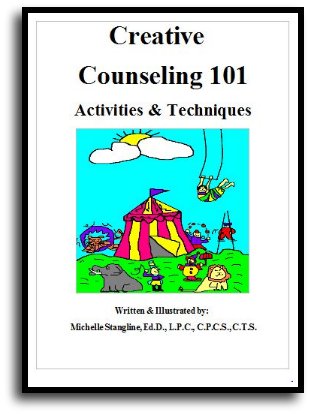
Step By Step Therapy:
Learn how to be a more Creative Therapist with the Book that started it all!
- Graduate School Counseling book used by hundreds of graduate counseling students!
- Includes full color reproducible worksheets with most activities.
- Winner of the Counselor Writer of the Year Award, 2011, Georgia Regional Award
Download Your Copy Today Only $39.95:
See Creative Counseling 101 eBook Information Here:
Get the Set
of all four
eBooks for only $98.95:
An incredible collection of how to do therapy eBooks!
A $159.80 Value,
You Save Over $60!
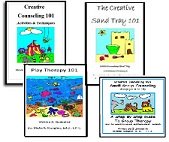
Get your complete set of the Creative Counseling 101.com eBooks by Dr. Michelle Stangline for only $98.95, that's less than $25.00 per eBook (Regular Price is $39.95 for each eBook.).
Your complete set includes:
- Creative Counseling 101
- Creative Group Counseling 101
- Creative Play Therapy 101
- Creative Sand Tray 101
For more information click the link below:
See Complete Set of eBooks For Sale Here:
New!!! "Beyond Art Therapy" 101 eBook
Over 300 pages of Beyond Art Therapy activities and techniques. Learn what I teach graduate counseling students!
See the link below for more information.
Only $39.95
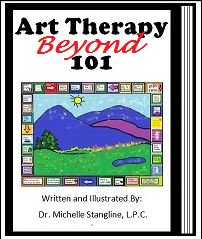
See More Invividual eBooks For Sale:
Sand Tray Therapy 101 eBook:
Learn how to do Sand Tray Therapy or enhance your skills.
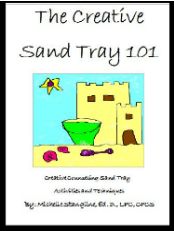
Play Therapy 101 eBook
Learn how to do play therapy or enhance your skills.
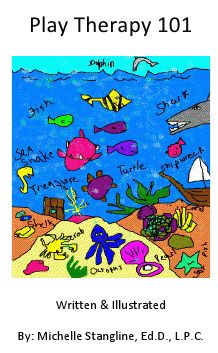
Small Group Counseling eBook For Sale:
Learn how to do creative group therapy and enhance your skills.
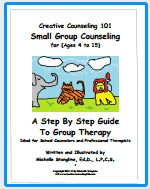
School Counselor Guidance Lesson & Social Stories eBook for sale:
Get a year's worth of school counselor guidance lessons with "Creative Warm & Fuzzy Classroom Guidance Lessons eBook". Introduce your students to the "Warm & Fuzzy Way". Click the link below for more information:
Warm & Fuzzy School Counselor Guidance Lessons eBook
